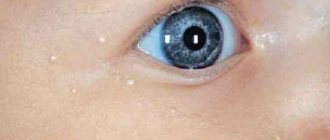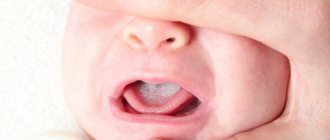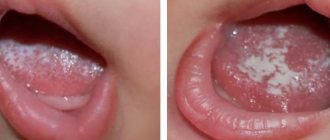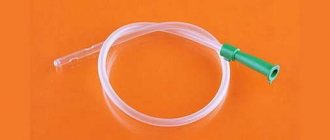20.12.2016
When a baby begins to refuse the breast, and a white coating is found in the oral cavity, parents may suspect candidiasis in the newborn. The disease is caused by fungi of the genus Candida.
In advanced cases, fungi can spread to internal organs, but this pathology is rare in children. You should not neglect treatment - the disease “itself” will not go away, but with timely measures, both parents and the child will not experience discomfort for a long time.
Is there a fever with thrush?
Thrush, a disease caused by yeast-like fungi Candida, should occur without a change in body temperature.
These pathogenic microorganisms can colonize the genitals, intestines and oral cavity. An neglected condition can lead to complications, a weakening of the immune system, when various infections begin to penetrate the body, causing an increase in temperature. The main clinical picture of thrush is not characterized by an increase in low-grade fever. In the initial phase, the fungal infection is localized - only the mucous membranes of the genital organs are affected. When the disease begins to progress, damage to internal organs occurs, as a result of which the body temperature rises.
Diagnostic methods
Diagnosis of thrush begins with an examination by a doctor. He studies the clinical picture and assesses the general condition of the child.
To make a diagnosis, the following is carried out:
- interviewing parents and reviewing their medical history;
- physical examination (examination of the mouth and other parts of the body);
- laboratory tests for thrush: microscopic examination of scrapings from the oral mucosa to identify bacteria in the body, bacteriological examination of blood serum to determine the type of fungus that caused the disease and its susceptibility to antibacterial agents.
How to spot thrush in time
It is extremely difficult to recognize oral thrush in children by the first symptoms: redness and swelling that can appear on the roof of the mouth, tonsils, gums, tongue and the inside of the cheeks. Next, on the red shiny background of the mucous membrane, which is already beginning to hurt and itch, white grains appear, similar to semolina. They can be easily removed with a spoon.
The next stage will be an increase in plaque, which is already becoming similar to the remains of cottage cheese in the mouth (less often, it has a grayish or yellowish tint). If you remove them with a blunt object (spoon, spatula), a red shiny surface will be visible underneath them, on which, if you scrape hard, droplets of blood appear, resembling dew.
Changes in the mucous membrane are accompanied by pain and burning in the mouth. They get worse when swallowing and eating food, especially if it is spicy, hot or sour. There is also a metallic taste in the mouth. Because of this, the child cries and refuses to eat. In the absence of treatment at this stage, or if the child’s immunity is severely suppressed, the white films spread further and further, the body temperature rises, sleep is disturbed, the infant may spit up frequently and stop gaining weight.
The feeling of a “lump in the throat,” which only older children can complain about, is a sign that the thrush has spread to the throat.
Sometimes thrush in children looks like a jam - a crack in the corner of the mouth. It differs from cracks formed due to vitamin A deficiency in that there is redness around the crack, and it itself is covered with a whitish coating. Candidiasis is rarely accompanied by fever or deterioration of the general condition, but it makes opening the mouth painful. This form of thrush occurs more often in children who suck a pacifier or thumb.
Thus, parents of infants should be wary and examine the child's mouth if he:
- cries when he puts a pacifier or breast in his mouth;
- refuses breastfeeding;
- capricious, he has an elevated temperature without snot and cough.
Characteristic symptoms and stages of development of thrush
Depending on the stage of development of thrush, symptoms may vary slightly. So, there are several stages of the disease:
- mild - characterized by the appearance of small red spots or ulcers in the mouth, which over time become covered with a dense white coating. A white film forms on the mucous membrane of the mouth and when you try to remove it, slight bleeding may occur in the oral cavity.
- The middle stage of candidiasis - the entire oral cavity is filled with a cheesy white coating, under which painful, bleeding ulcers form. It hurts the child to suck and swallow, so he refuses to eat. The sense of taste is lost, an even thicker coating appears on the tongue, and small cracks appear in the corners of the mouth.
- Severe stage of thrush - mouth ulcers bleed heavily, plaque appears on the gums, palate and inside of the cheeks. The cavity is completely covered with a white film and the baby experiences intense pain. At this stage, his general health deteriorates noticeably, and his body temperature rises to 37-38°C.
The mild stage can be dealt with at home. And in case of moderate or severe illness, you cannot do without the help of doctors.
How to reduce the temperature?
If you have thrush, the elevated temperature should be reduced with medications prescribed by your doctor to avoid exacerbation of the condition, since some antibiotics stimulate the proliferation of fungi. The temperature should be reduced if the mark on the mercury column reaches 39 degrees. It is correct to take the following measures:
- Go to bed in a well-ventilated room;
- If a child’s temperature is elevated, he should be kept from active actions;
- Drink more fluid. Fruit drinks, green tea, homemade compotes are useful;
- Do rubbing with a mixture of vinegar and water (1:1);
- Take antipyretic medications.
To bring down the temperature, medications are prescribed, the active ingredients of which are Ibuprofen, Aspirin, Paracetamol, Nimesulide.
In order to make an accurate diagnosis, the following examinations are carried out:
- Examination on a gynecological chair using colposcopy (women);
- Examination of a smear from the mucous membrane of the cervix and vagina;
- Bacterial culture of a smear;
- Determination of the susceptibility of Candida fungi to antimycotic drugs;
- Determination of blood sugar levels;
- Gastrointestinal examination.
After confirming the diagnosis, treatment is prescribed including antifungal drugs and agents (suppositories, vaginal tablets, creams). In case of complicated candidiasis, systemic antifungal medications are used. Effective drugs for the treatment of thrush are:
- Nystatin;
- Fluconazole;
- Pimafucin.
In some complicated cases, complex treatment is prescribed in order to eliminate the developed pathology against the background of a fungal infection. Inflammation of the reproductive and urinary system may require therapeutic treatment for about 6 months.
We suggest you read: Is it possible to treat teeth during menstruation - permitted and prohibited procedures
An individual approach is required by expectant mothers carrying a child, since treatment of pregnant women should be carried out with extreme caution.
It should be remembered that temperature with thrush is not a sign of the fungal infection itself, but only signals complications and the development of concomitant diseases.
Nutritional Features
During the period of illness, it is extremely necessary to adhere to a gentle diet, but at the same time, the child must receive adequate nutrition. Besides:
- Give children of all ages simple boiled water more often;
- include more fermented milk products with bio- and bifid additives in your diet;
- If possible, prepare dishes pureed (soups, purees, creams, liquid cereals, omelettes, smoothies);
- It is advisable to make steamed cutlets from meat and fish, which should include onions and garlic;
- add a little salt to your food and don’t eat a lot of sugar - it promotes the growth of candida;
- Avoid sweets, chocolate and spices altogether.
For young children, the process of care and strict adherence to all recommendations by adults is very important. That's why:
- make sure that your home is wet cleaned with dusting and airing at least twice a day every day during the course of treatment (air humidity should be in the range of 40-60%, and the ambient temperature should be 19-20°C) ;
- do not forget, during hygiene procedures for infants, to promptly remove crusts from the nose so that he can breathe more freely and his mouth does not dry out;
- go out into the fresh air with your child every day (dressing for the weather);
- to wash children's dishes, use natural products (soda, mustard, boiling water);
- take care of the cleanliness of your hands and the condition of your oral cavity, and indeed your health in general;
- limit access to pets during illness;
- use traditional medicine.
Oral thrush is a contagious disease caused by yeast-like fungi of the genus Candida. It can develop at any age, and in children, starting from preschool age, it is a kind of marker of decreased immunity or the development of diabetes.
At the age of up to one year, it most often occurs due to the forced use of antibiotics by the child or his nursing mother, and in newborns - when passing through the birth canal colonized by Candida during childbirth.
And although the disease is registered in every fifth baby, at this age it is better treatable. The main thing is to pay attention to it in time and perform only those actions that the local pediatrician recommended in your case.
Treatment of newborns and infants
Pediatric doctors indicate that mild forms of thrush in the mouth of a newborn child do not require treatment. It is enough just to take measures to alleviate his condition.
It is necessary to maintain cleanliness in the room. The temperature should be no higher than 19°C, humidity – about 40-60%. Don't forget that mold grows quickly in warm, damp air. Its appearance will cause even more serious diseases, the treatment for which is much more difficult than for thrush. Mold develops when air humidity is above 75%. Therefore, it is necessary to frequently ventilate the room, maintaining optimal conditions.
As pediatrician E. Komarovsky emphasizes, parents need to monitor normal nasal breathing, otherwise the oral mucosa will dry out, microcracks will appear, and fungus will begin to develop. If the mucous membranes are in normal condition, the growth of fungi will stop and thrush will disappear without treatment.
In case of advanced thrush, treatment should be carried out only with the help of medications. The oral cavity is treated with solutions of antiseptic and antifungal agents. To clean the oral mucosa in children, doctors and traditional healers recommend using a solution of baking soda (1 teaspoon per 1 liter of water) or a 1% solution of hydrogen peroxide. Moisten a sterile cotton swab and wipe the baby's entire mouth.
The affected areas are treated with a nystatin suspension (the tablet is crushed, a few tablespoons of slightly warm water are added). This treatment is repeated up to 6 times a day. For the same purpose, a Candide solution based on clotrimazole is used (used only as prescribed by a doctor). Treatment is carried out 2-4 times a day.
If the baby is already 6 months old, then in case of moderate or severe disease, treatment is carried out with the drugs “Futsis DT”, “Fluconazole”, “Diflucan”, “Mikosist”. The dose is calculated by the doctor individually, taking into account the child’s weight.
Preventive measures against candidiasis
Methods that will help avoid the development of a fungal pathogen and prevent thrush logically follow from the causes of the disease. If from the moment of pregnancy the expectant mother takes care of her health, and from the first days of the child’s life takes proper care of him, candidiasis can be avoided. The main preventive measures for this can be called:
- Regularly visiting a doctor, monitoring your own health and solving any ailments that arise at the initial stage.
- Maintaining personal hygiene of a young mother and child.
- Compliance with the rules of washing and sterilizing dishes for a newborn.
- Maintaining an optimal climate in the apartment - temperature and humidity, which contribute to the healthy formation of a strong immune system.
- Breastfeeding on demand. If possible, it is better to refuse formula and complementary foods until the baby reaches six months of age. This will help strengthen the immune system and also eliminate the need to wash and sterilize bottles.
- At least twice a day, and in the summer – as often as possible, go for a walk. Staying in the fresh air is one of the simplest and most effective ways to strengthen the immune system.
Thus, measures to prevent thrush are not complicated, but following them from the first day a child is born will help protect him and protect him from the development of the Candida pathogen. A newborn’s immunity is not yet able to cope with all threats from the outside world, so it is important to help him be healthy.
About the pathogen
Candida that causes thrush is a whole group of different fungi: Candida albicans, Candida krusei, Candida tropicalis and pseudotropicalis, Candida guilliermondi. They live in the environment, as well as in the mouth, vagina and colon of humans, coexisting peacefully with other microorganisms and, as long as the immune system is strong, without causing signs of illness.
As soon as special conditions are created in the body (general immunity decreases or the pH of the mucous membrane increases), Candida begins to actively multiply - thrush develops. The same situation can develop if a fairly large number of mushrooms of a more “aggressive” subspecies come into contact with a person from the environment.
The “favorite” conditions for the development of the Candida fungus are an acidic environment and a temperature of 30-37 degrees. Then they penetrate deeper into human tissue, secreting enzymes that dissolve tissue components (mainly proteins), and begin to multiply. Numerous nerve endings approach the tissues of the mucous membranes of the mouth and pharynx, and when the cells are damaged, a signal goes through the nerves to the brain, and it gives the command to notify the person himself so that some measures can be taken. This is how the symptoms of thrush arise: pain, burning in the mouth, which is why the child refuses to eat and drink.
When favorable conditions are created for the Candida microbe, it actively multiplies, forming long chains of cells with a weak connection between them - pseudomycelium. This structure, as well as destroyed mucosal cells, food debris and substances called fibrin and keratin, is the white coating that is found on the mucous membranes with thrush.
Having multiplied in sufficient numbers, microbes acquire the ability to spread along healthy tissues - skin and mucous membranes. Thus, a complication of untreated oral thrush can be damage to the pharynx, esophagus and other internal organs. The fungus can also enter the bloodstream, causing blood poisoning - sepsis.
Candida is easily transmitted from person to person through direct contact of infected skin or mucous membranes with uninfected tissue. And if at a certain moment the microbe finds itself in a situation unfavorable for its own life and reproduction, it becomes covered with a double protective shell and goes into “hibernation,” which can last indefinitely.
Traditional methods of treatment
Sea buckthorn oil or tea tree oil. They have antimicrobial and wound-healing effects, relieve itching and pain. Apply to lesions 2-3 times daily.
Infusion of chamomile, oak bark, calendula, sage. Prepared in a combination of all components or each separately. Dried chamomile flowers, oak bark, marigold flowers and sage leaves purchased at the pharmacy - place 1 tablespoon each in a liter glass jar and pour one liter of boiling water. Close the container with a tight lid and wrap it in a terry towel. Leave for 30-40 minutes. Cool the infusion and wipe the baby’s mouth with warm water or use it as a rinse (up to six times a day). Store no more than a day in the refrigerator.
Cabbage and aloe juice. We can only use it fresh. Cooking method:
Apple vinegar. An acidic environment is detrimental to any fungus, so diluting a couple of teaspoons equally with boiled water will give you an excellent remedy for treating mucous membranes.
Signs of thrush in newborns, infants, temperature during thrush
Candidiasis is a yeast-like fungal infection that affects the mucous membranes of children. This infectious-inflammatory process is usually caused by decreased immunity.
Signs of thrush in children under one year of age are a fairly common occurrence in pediatric practice. Moreover, both in newborns and in older children, fungal infection occurs equally often.
Candida fungus, present in small quantities in the normal microflora of a child, under certain conditions begins to multiply uncontrollably, affecting the skin, mucous membranes of the genitals, intestines and oral cavity. Signs of thrush in newborns and older children depend on the location of the infection:
Signs of thrush in infants are most often observed in the oral cavity. During the first six months, mild symptoms of thrush in an infant are not considered abnormal. The white grains, like cottage cheese, covering his tongue and the insides of his cheeks do not bother him at all. After all, the plaque, reminiscent of milk residues, is easily removed, has no odor and does not ulcerate the mucous membrane.
More severe forms of oral candidiasis have other distinctive signs of thrush in infants and older children. The characteristic plaque spreads to the lips and palate and becomes in the form of films that are difficult to remove, leaving bleeding ulcers after removal.
In the initial stage, the temperature of thrush in children almost never rises. If the infectious-inflammatory process spreads, affecting a large area and penetrating deep into the tissues, then the temperature can be either low-grade (37.2) or very high (39.00 and above). Temperature during candidiasis is a sign of the extent of damage to the body by microorganisms and the stage of the inflammatory process. It is also a characteristic indicator of an infectious disease, regardless of where the infection manifests itself: in the mouth, in the intestines or on the skin.
- Symptoms of candidal dermatitis are also common in infants. The skin of a newborn baby is very delicate and therefore prone to diaper rash. Violation of the integrity of the skin provides favorable conditions for the penetration of yeast-like microorganisms that cause inflammation. Candidiasis on the skin most often appears in the folds of the neck, legs, thighs and between the buttocks.
- Diarrhea, increased gas formation, cramps, and the presence of flakes in the stool indicate a fungal infection that develops in the child’s intestines. Only a doctor can diagnose it by doing laboratory tests of stool to determine the composition of the microflora.
Degrees of the disease and their manifestations
Easy. There is hyperemia (redness) of all visible mucous membranes. And:
- whitish coating on the tongue (but sometimes it appears after feeding with milk and is easily eliminated if you give the child something to drink);
- the formation of small red spots on the inner surface of the lips and cheeks, which turn into dense white grains, increase in size and take on the appearance of curd grains;
- swelling and itching of the gums, tongue and palate, frequent regurgitation, because... babies under 3 months have difficulty swallowing, or even children do not want to eat, spitting out the pacifier or refusing to grab the nipple;
- The general condition of the little patient suffers: sleep is disturbed, the baby shows restlessness, puts its hands in its mouth, and loud crying is often heard.
Heavy. Occurs due to failure to take proper measures in treatment. Wherein:
- the entire oral cavity is covered with dense gray-yellow films;
- swelling and hyperemia reach the pharynx, provoking a purulent process - sore throat;
- a constant low-grade fever is recorded for several days;
- general condition worsens, weakness and lethargy appear, no appetite;
- The mucous membrane of the gums cracks and bleeds.
Mild and moderate severity is cured quite quickly, causing only an acute form of the disease. Here it will be sufficient to undergo treatment at home, but strictly following all the doctor’s recommendations.
Severe thrush can provoke complications, as well as transition to a chronic form, spreading a fungal infection and affecting other organs and tissues. It causes dehydration and starvation, further weakening of the immune system, and the appearance of foci of inflammation in the lymph nodes, in the pulmonary, digestive and genitourinary systems. In this case, you probably will not be able to fight alone; you will have to resort to inpatient therapy.
Important! Thrush, especially in children, is a serious contagious disease and requires careful attention. At the first symptoms, be sure to contact your pediatrician. Only a specialist will help to correctly resolve the problematic issue - make a diagnosis and prescribe adequate treatment.
Causes of the disease
Thrush in a child’s mouth occurs when a fungus gets on his mucous membranes:
| In a newborn (from 1 to 28 days of life) | In a one month old baby | In children under one year old | In children older than one year |
The chance of infection is especially high in premature babies, children born to mothers with tuberculosis, and HIV infection. |
The risk of occurrence is especially high in premature babies and those whose mothers have tuberculosis or HIV infection. | The main reasons are the same as for children under one year old. Also, children under one year old get sick when:
| The reasons are the same as for children under one year old. Also added:
Thrush in the mouth of such children may be the first sign:
Dysbacteriosis due to poor nutrition, taking antibiotics, smoking and using drugs or alcohol (this happens in adolescents), and taking oral contraceptives increase the chance of getting sick. |
We invite you to familiarize yourself with Your mouth is full of worries. Thrush in a baby
Thrush appears very often in an infant - up to one year, 5-20% of children suffer from this disease, some more than once. This is explained by the fact that the immunity of the mucous membranes of the mouth in such babies has not yet been formed; the microflora living there is subject to frequent changes. And the epithelium itself, from which the surface of the oral cavity is made, is not yet fully formed. Therefore, thrush that occurs before one year is not a reason to panic.
An urgent need to be examined arises if parents see thrush in the mouth of a child over one year old, when he has not taken antibiotics in the next month.
Prevention for a child
For the most part, all preventive measures for a baby, including a two-month-old toddler, fall on the shoulders of his mother. Who, if not she, will devote all her time to him. To prevent thrush from coming to visit, mothers are obliged to bathe and wash the child, not wrap him in a hundred clothes, and often leave him without a diaper, since a humid environment is suitable for the active life of opportunistic microorganisms. It is also important to follow the following rules:
- Monitor the condition of the oral mucosa. If dryness is noted, you need to drink some water. Even a few sips will be enough.
- Clean the apartment, ventilate it, monitor the temperature and humidity. Overheating and hypothermia of the baby should be avoided.
- Breastfeed, because breast milk is a vitamin product that is simply necessary for the weak body of young children.
- Temper, wash your hands thoroughly, disinfect pacifiers, rattles, and other toys used by the child.
- Keep away people with thrush.
- When artificially feeding, follow all the rules: keep it in a column, after eating, put it in the crib for 10 minutes, do not disturb it.
- Do not buy sweet mixtures so as not to feed harmful fungal agents.
Forecast
Thrush in its various manifestations affects about 20% of newborns and children under one year old. A fungal coating on the tongue, similar to the remains of breast milk or formula, is a common occurrence for babies of this age.
For parents of a healthy child, it is enough to follow preventive measures and regularly treat the baby’s oral cavity with soda solution to avoid more pronounced manifestations of a fungal infection.
In children with weakened immune systems, thrush is treated until the symptoms disappear completely and the test result is negative (sensitivity culture - 10³ CFU/ml), this may take from 7 days to a month.
Fungal infection in the mouth of a newborn is completely curable (99–98%), only in 1–2%, with a combination of factors (prematurity, congenital diseases, HIV infection), candidiasis becomes generalized and leads to death.
Treatment for thrush diagnosed in a child’s mouth
Treatment requires an integrated approach, which involves:
- destruction of the cause of the disease - candidal infection;
- relief of the main symptoms;
- increasing the protective forces of the still unformed organism of children;
- restoration of normal microflora.
Important! Strict adherence to medication prescriptions and care rules will speed up recovery and help avoid unwanted complications.
Parents and grandmothers of young children in the first year of life, as a rule, are very attentive to their precious health, instantly noticing the onset of the disease. Treatment during this period is not complicated and quite quickly gives a positive result.
To relieve the first symptoms, it is enough to use an alkaline 2% solution of baking soda. It is prepared at the rate of 1/4 teaspoon of powder per 1/2 cup of boiled water. Dissolve the soda well. Then mommy wraps a bandage or a piece of gauze around her index finger in two or three turns so as to completely cover it. Moistens it in the solution and gently treats the baby’s mouth and tongue.
To achieve the best effect after the soda procedure, proceed in the same way with 3% peroxide, but with a new bandage.
This manipulation is carried out every time after feeding, not forgetting that after milk the child needs to be given a couple of spoons of plain boiled water.
For older children who know how to rinse their mouths, the solution is prepared at the rate of 0.5 tsp. soda to 1 glass of water. Rinse 4-5 times a day.
If signs of moderate severity of candidiasis are noticeable, then medications are used. The pediatrician prescribes nystatin in tablet form to prepare a suspension (for infants).
How to prepare the suspension? We would like to remind you that this solution is opaque and contains small crystals of the drug. So, take one tablet and place it between two teaspoons, pressing on them with your fingers, grind the tablet into a powdery mass. We dilute the product in half a glass of warm boiling water. To apply it as evenly as possible to the affected areas, we’ll make a swab ourselves by wrapping a piece of cotton wool in a bandage and securing it with thread. A spatula, also wrapped in cloth or gauze, is excellent for wiping. The course of treatment is 5-6 times a day until the manifestations of the disease disappear.
Nystatin is indicated for children after three years of age:
- in the form of rinses - for which one mixed nystatin tablet is mixed with one ampoule of cyanocobalamin (vitamin B12) for intramuscular injection and two teaspoons of boiled water. Blot the affected areas with liquid two to three times a day (until recovery);
- with manifestations of cheilitis, nystatin is suitable in the form of an ointment, which is applied to the skin in the corners of the mouth in the morning and evening (in combination with an antiseptic, for example, hydrogen peroxide).
Since you will have to solve problems not only with the oral mucosa and lips, but also with the general well-being of the child, use the antiallergic Fenistil, which relieves itching, as well as the antiseptic Hexoral in the form of an aerosol or solution to prevent possible suppuration. The complex of vitamins and minerals will have a general strengthening effect. Just be sure to consult your doctor, and try not to self-medicate.
Symptoms of thrush
Thrush in young children manifests itself with a number of characteristic signs:
- The appearance of a dense coating on the mucous membrane. In this case, there are plaques and spots that are covered with a dense layer of plaque. If you remove it with a cotton swab, then bleeding ulcers appear at its location. They cause serious infections to enter the child’s body.
- Characteristic discomfort and pain. If thrush is not treated promptly, then, after some time, the child becomes restless and begins to eat poorly. Ulcers that cover the mucous membrane of the oral cavity cause pain when sucking.
- Increased body temperature. This symptom occurs in advanced cases and requires the use of antipyretic drugs. This is the body's response to pathogenic microflora.
It is not difficult to diagnose thrush on your own, but despite this, treatment is not recommended. Before treating thrush in newborns, it is necessary to undergo a comprehensive examination and consult an experienced specialist.
What can be done to help the baby?
Thrush in newborns and infants is treated with antiseptics and antifungal drugs.
Local processing
For mild cases of the disease, in most cases, treatment of the oral cavity with a 3% soda solution is prescribed, the preparation of which requires a glass of cooled boiled water and a teaspoon of soda.
A gauze swab is moistened in the solution, which is used to very carefully wipe the areas of the mucous membrane affected by the fungus. The procedure helps change the acidity in the mouth, preventing further proliferation of candida. The treatment should be repeated every 3 hours.
A nursing mother will also need a soda solution to treat her breasts before each feeding.
General therapy
How to cure candidal stomatitis if treatment with soda solution does not produce results?
If no positive effect is observed within several days, therapy with special medications is required, which can only be prescribed by a doctor. We are talking about antimycotics that neutralize fungal infections.
At the discretion of the doctor, Nystatin and Diflucan may be prescribed in dosages appropriate to the baby’s age. The powder consistency of the drugs allows them to be mixed with breast milk or formula, which makes taking the medications much easier.
A Candide solution containing clotrimazole is used topically. Apply 10 drops to a cotton swab and lubricate the affected mucous membrane, having previously cleaned it of cheesy deposits.
Sanitation of furnishings
Proper treatment of toys, bottles and nipples with which the baby comes into contact is also important when treating oral thrush in children. Treatment is carried out by washing in a soda solution or boiling.
Recommendations for the treatment and prevention of oral thrush in children from Dr. Komarovsky:
Causes of candidiasis in an infant
Candida coexists with beneficial gut bacteria. Fungi begin to colonize the baby's digestive tract already in the first months of life. Many people are asymptomatic carriers of candida, but when their immunity decreases, they begin to notice the first signs.
Under the influence of certain factors, fungi begin to become active, constantly increasing their colonies. Aggressive properties appear when there is a large amount of candida. Germination of fungi and damage to cells of the mucous membranes leads to candidiasis.
Scientists have identified several types of microorganisms from the genus Candida that contribute to damage to the mucous membranes of children. When fungi multiply, the skin of the intergluteal folds and groin area may also undergo changes. Most often, laboratory tests reveal pathogens of the Candida albicans type.
Preventing the development of candidiasis in newborns consists not only in the fight against fungi located inside and outside the body, but also in eliminating factors that contribute to the proliferation of the pathogen.
The main causes of thrush in a baby are:
- Infection of a baby by parents who do not follow hygiene rules. Fungi are often transmitted during breastfeeding.
- Infection at birth. Candidiasis in infants often develops if the mother suffered from a fungal infection before conception and during pregnancy.
- Dry air. Under unfavorable environmental conditions, the baby’s immunity is not able to fight candida and bacteria. In the first months of life, the body's defenses continue to develop, and the baby quickly picks up an infection.
- Lack of disinfection of nipples and bottles. If sterilization is poor, the baby may become infected with candidiasis.
- The use of antibacterial medications. Even with a short course of treatment with such drugs, an infant may develop a fungal infection.










